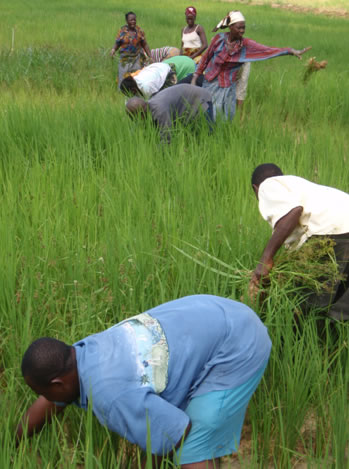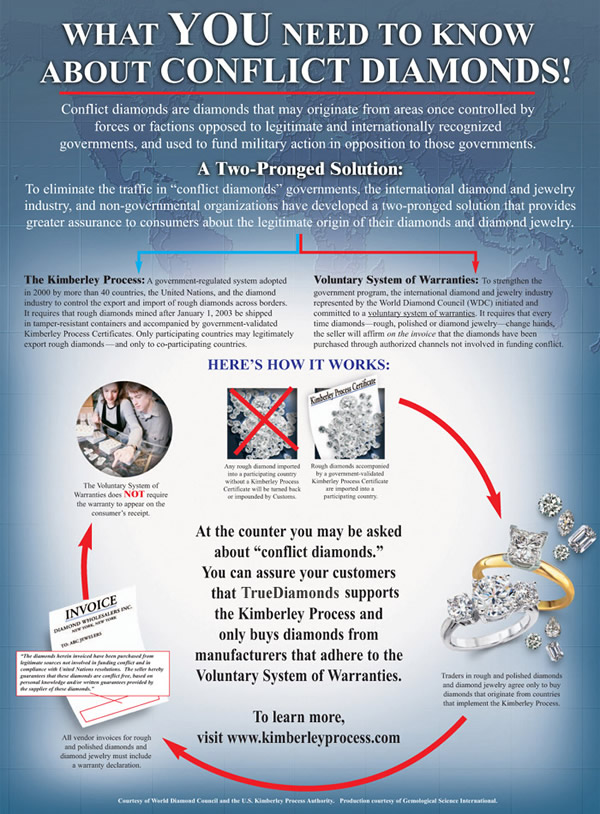The internecine wars, which took place in the 1990s in Angola, the Democratic Republic of the Congo, Liberia and Sierra Leone, were largely bankrolled and fuelled by trade in conflict minerals, particularly diamonds.
With the civil society keeping an eagle eye on these countries and exposing how diamonds fuelled the clashes there was a growing awareness of the so-called blood diamonds at the turn of the new millennium.
As this public awareness grew to a crescendo, fears of a consumer boycott gripped the diamond industry and governments of countries with diamond economies.
In May 2000, according to a report released last September by the Kimberley Process (KP) Civil Society Coalition, the major diamond trading and producing countries, representatives of the diamond industry, and concerned civic bodies responded to the invitation of the South African government to meet in the town of Kimberley, where discussions focused on how to tackle the conflict diamond problem.

The result of that meeting was KP and the start of a tight three-year negotiating exercise to establish a certification system for rough diamonds.
So, 2003, was the year that the parties agreed to launch Kimberley Process.
[two_third]
The diamond watchdog set up a peer review system, which provided it with a framework for monitoring implementation.
This indeed helped reduce the flow of conflict diamonds in Africa and improve transparency as far as diamond mining and trading is concerned.
“As much as 15 percent of the world’s $10 billion annual rough diamond production in the mid and late 1990s fell into the category of conflict diamonds,” the KP Civil Society Coalition noted.
“Since then, the proportion has fallen to less than 1 percent of a rough diamond industry now worth some $13 billion, in part thanks to the negotiation and implementation of the KP.
[/two_third][one_third_last]
“As much as 15 percent of the world’s $10 billion annual rough diamond production in the mid and late 1990s fell into the category of conflict diamonds. Since then, the proportion has fallen to less than 1 percent of a rough diamond industry.”
[/one_third_last]
“Côte d’Ivoire, which remains under UN embargo, and the Central African Republic are currently the only countries where conflict diamonds, as defined by the UN, still exist.”
The coalition pointed out that KP’s regulatory mechanism forced most of the industry to avoid illicit diamonds – diamonds that may have nothing to do with conflict but are nevertheless stolen, smuggled, used for money laundering, tax evasion and the like.
KP also provided a framework for bilateral assistance on technical issues, such as mining legislation, police training, registration of miners, and diamond valuation.
However, critics argue that KP’s claim of a 99 percent clean diamond industry exist largely because the real violence of the industry was whitewashed, ignored, or excluded entirely from the framework.
“In the end, if the Kimberley definition remains limited to rebels, rather than the far broader array of often unsavory players who have forced their way into the industry, violating the letter and spirit of the system, there may be no fundamental way to save the diamond industry,” investigative journalists Khadija Sharife and John Grobler wrote recently.
“The Kimberley Process as it is currently defined is a system that produces the wrong kind of results. It would be difficult, if not politically impossible, to reform the Kimberley Process in its current form, particularly as it took the better part of two years to originally negotiate with all the diamond industry players. Still, a few tweaks could help curb the illicit off shore-based trade.”
This view was also shared by Belgium, which is home to Antwerp, the world’s largest diamond trading hub.
Some Belgian legislators recently argued that Kimberley Process was not “sufficiently effective”.
They noted that diamonds from conflict areas, as well as from countries where there are obvious violations of human rights continue to be supplied to the market despite the countermeasures taken.
The legislators, therefore, came up with “appropriate” resolutions, which were submitted to Parliament for possible adoption.
These included tighter control over diamond supply, as well as for exchange of information with other data banks on mineral resources to avoid possible fraud.
If approved by local parliament, the resolutions would be handed over to the European Commission.
The civil society and parts of the diamond industry have also been calling for stronger oversight and better internal controls in some producing and importing countries.
Here we reproduce, largely verbatim, the issues and challenges dogging Kimberley Process that were published by the KP Civil Society Coalition.
Indeed, these also resonate with concerns raised by other interested groups and individuals.
This, dear reader, should be able to help us determine whether critics of KP are being too harsh or not.
 Internal controls – artisanal producers
Internal controls – artisanal producers
In artisanal producing countries, internal controls are often weak and it is argued that the authorities in these countries cannot say with any assurance where up to 25-50 percent of the diamonds they export actually come from. The origin of diamonds is the only agreed standard of major importance in the KP, that is the ability of a Participant to confirm that its diamonds come from a known, clean source. Despite KP Review Visit reports and civil society studies which have offered recommendations and assistance, little seems to have changed in some countries during the decade that the KP has been in operation.
Internal controls – trading centers
Producing countries rightly question the commitment of the authorities in many importing countries, and particularly in the trading centres, towards implementing strict import controls. Diamonds are smuggled out of a number of countries – for example Venezuela, Côte d’Ivoire and the main artisanal producing countries – but diamonds are rarely seized on entry into importing countries, with few if any arrests made. The playing field is far from level, as some jurisdictions attempt a certain level of controls, whereas others appear uninterested. Overall, the commercial imperative of moving diamonds as quickly as possible seems to prevail above all else.
Monitoring
The current peer review mechanism is not as effective as it should be. Some review teams produce excellent and thorough evaluation reports, with very useful recommendations. But in other cases review reports are very late being produced and there is little or no follow-up. Because participation on review teams is ‘voluntary’ and costs are borne by the Participant, some countries participate in more reviews than others, and some never participate at all. Civil society and industry bear a disproportionate cost in fielding team members, for there is no burden sharing. The Kimberley Process needs to develop a stronger monitoring and research arrangement that sets a high standard of evaluation, avoids conflicts of interest, and ensures follow-up.
Sanctions in cases of non-compliance
The KP has the possibility of suspending a Participant in cases of serious non- compliance but there is no agreed definition of ‘serious non-compliance’ and there is an extreme reluctance to impose any kind of suspension. The KP should develop a credible graduated sanctions tool that can and will be applied in cases of non-compliance.
Transparency
The Kimberley Process core document states that “Participants and Observers should make every effort to observe strict confidentiality regarding review mission reports and the discussions relating to any compliance matter”. During the early years of the KP, transparency was a hotly debated issue. Some Participants argued that all information and statistics related to diamond trading should remain secret, citing ‘commercial confidentiality’. Review Visit reports remained largely confidential because, it was said, some governments would not be open to full scrutiny if potential problems risked being made public. Although there is now agreement that annual and review reports should be placed on the public part of the KP website, unless Participants explicitly note that (sections of) the report shall not be published, this has not been put into practice. Civil society believes that all KP monitoring reports, participants’ annual reports, and statistics should be made public.

Decision-making
The KP core document states that “Participants are to reach decisions by consensus. In the event that consensus proves to be impossible, the Chair is to conduct consultations”. Consensus in the KP has come to mean “unanimity”, rather than “strong majority” and this has slowed progress on a wide variety of issues, small and large. Whilst the KP Civil Society Coalition acknowledges the merits of a consensus decision-making approach, it believes that this must be complemented by a voting system to facilitate more efficient decision-making. Almost every institution in the world operates this way.
Conflict diamonds definition
The KP’s definition of conflict diamonds is both too limited and outdated, for it does not address the way in which violence in diamond producing areas has evolved in the decade since the Kimberley Process was formed. The United Nations General Assembly resolution 55/56 adopted on December 1, 2000 defines conflict diamonds as “…rough diamonds which are used by rebel movements to finance their military activities, including attempts to undermine or overthrow legitimate Governments”. The KP definition of conflict diamonds adopted in 2002 is narrower than the UN General Assembly definition, in that it applies only to rebel movements that are actually trying to overthrow a government, thereby excluding the activities of other militias and armed forces (for example Zimbabwe in 2008 and CAR in 2010).
Human rights
The second paragraph of the preamble in the Kimberley Process core document speaks of “The devastating impact of conflicts fuelled by the trade in conflict diamonds on the peace, safety and security of people in affected countries and the systematic and gross human rights violations that have been perpetrated in such conflicts.” Civil society believes that human rights have always been at the core of the KP mandate and that this commitment should be clarified through the introduction of explicit human rights language in KP documents.
The Kimberley Process must include respect for human rights in its minimum standards for all Participants. The provision and administration of security measures in Participants’ diamond mining sectors should be consistent with international human rights law. As a means of addressing the potential for smuggling and other concerns relating to KP compliance in artisanal diamond mining, Participants should further provide and administer security standards and measures consistent with international human rights law with respect to diamond miners and members of local communities.
